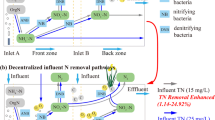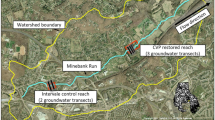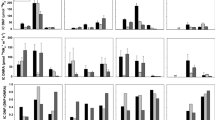Abstract
A restored drained wetland should provide a comparable environment to remove nonpoint source nitrogen (N) from animal feeding operation (AFO) runoff as an equivalent constructed wetland. Our research addresses the N removal efficiency of the drained and restored Long Acres Wetland (LAW) to its modeled constructed wetland equivalents, and the relationship of the five denitrifying variables of bacteria population size, bacteria-pollutant contact, N Cycle continuity, kinetics, and bacteria-pollutant contact time to rate their relative influence on N removal. Although, we found restoration improved percent total nitrogen removed (%TNR) from 90.9% to 94.6%, analysis of variance (ANOVA) of the actual drained versus actual restored %TNR datasets indicated no statistical difference. However, ANOVA of the actual restored versus modeled restored %TNR datasets showed a significant statistical difference, indicating that the actual restored LAW was not operating at its theoretical optimal efficiency. Subsequent ANOVA of the denitrifying variables’ pre- versus post-restoration datasets indicated that restoration had favorably influenced all denitrifying variables except bacteria-pollutant contact. Our results suggest lack of mixing was the limiting factor negating all other enhanced variables potential treatment contributions. Nevertheless, the actual drained LAW significantly removed N, indicating that drained wetlands maybe removing considerable N from polluted runoff.




Similar content being viewed by others
References
[ASWM] Association of State Wetland Managers (2000) Watershed-based wetland planning and evaluation. Proceedings of a Symposium at the Wetland Millennium Event Held August 6–12, 2000 in Quebec City, Quebec, Canada
[USDA NRCS] United States Department of Agriculture - Natural Resources Conservation Service (1990) Engineering field manual. Washington DC
[USDA NRCS] United States Department of Agriculture - Natural Resources Conservation Service (2000) Conservation practice standard: Constructed wetland Code-656. Available via DIALOG. www.ms.nrcs.usda.gov/constructedwetland.pdf
[USDA NRCS] United States Department of Agriculture - Natural Resources Conservation Service (2002) National engineering handbook chapter 3, Constructed Wetlands. Washington DC
[USDA SCS] United States Department of Agriculture—Soil Conservation Service (1982) Soil survey of Chenango County, NY. Washington DC
[USEPA] United States Environmental Protection Agency (1998) Environmental impacts of animal feeding operations. Washington DC
[USFWS] United States Department of Interior- Fish and Wildlife Service (2000) Watershed-based wetland characterization for Maryland’s Nanticoke River and Coastal Bays Watersheds: a preliminary assessment report
Andreassi CL, Banerjee A (2003) A Biogeochemical Comparison of Natural Versus Artificial Wetlands. Dissertation Carleton College
Bachand P, Horne A (2000) Denitrification in constructed free-water surface wetlands: II Effects of vegetation and temperature. Ecological Engineering 14:17–32
Baker LA (1992) Introduction to nonpoint source pollution in the United States and prospects for wetland use. Ecological Engineering 1:1–26
Bavor H, Roser D, Adcock P (1995) Challenges for the development of advanced constructed wetlands technology. Water Science and Technology 32:13–20
Bendoricchio G, Cin L, Persson J (2000) Guidelines for free water surface wetland design. Ecosystems 8:51–91
Boesch DF, Brinsfield RB, Magnien RE (2001) Chesapeake Bay eutrophication: scientific understanding, ecosystem restoration, and challenges for agriculture. Journal of Environmental Quality 30:303–320
Burns D, Nguyen L (2002) Nitrate movement and removal along a shallow groundwater flow path in a riparian wetland within a sheep-grazed pastoral catchment: results of a tracer study. New Zealand Journal of Marine and Freshwater Research 36:371–385
Carlsson F, Frykblom P, Liljenstolpe C (2003) Valuing wetland attributes: an application of choice experiments. Ecological Economics 47:95–103
Cedfeldt P, Watzin M, Richardson B (2000) Using GIS to identify functionally significant wetlands in the northeastern United States. Environmental Management 26:13–24
D’Amore D, Scott S, Huddleston J, Glassmann J (2000) Stratigraphy and Hydrology of the Jackson-Frazier Wetland, Oregon. Soil Science Society of America Journal 64:1535–1543
Davidisson T, Kiehl K, Hoffmann C (2000) Guidelines for monitoring of wetland functioning. Ecosystems 8:5–50
Driscoll CT, Whitall D, Aber J, Boyer E, Castro M, Cronan C, Goodale CL, Groffman P, Hopkinson C, Lambert K, Lawrence G, Ollinger S (2003) Nitrogen pollution in the Northeastern United States. Sources Effects, and Management Options 53:357–374
Fedler C, Sahu P, White T (2002) Improving wastewater nitrogen removal in Wetlands. The American society of agricultural engineers 2002 ASAE/CIGR International meeting
Fields S (1992) Regulations and policies relating to the use of wetlands for nonpoint source pollution control. Ecological Engineering 1:135–141
Follett R, Delgado J (2002) Nitrogen fate and transport in agricultural systems. Journal of Soil and Water Conservation 57:402–408
Gambrell R, Patrick W Jr (1978) Chemical and microbiological properties of anaerobic soils and sediments. In: Hook DD, Crawford RMM (eds) Plant life in aerobic environments. Ann Arbor Sci. Pub. Inc., Ann Arbor, pp 375–423
Gerke S, Baker L, Xu Y (2001) Nitrogen transformations in a wetland receiving lagoon effluent: sequential model and implications for water reuse. Water Resources 35:3857–3866
Gopal B (2003) Perspectives on wetland science, application and policy. Hydrobiologia 490:1–10
Hammer D (1992) Designing constructed wetlands systems to treat agricultural nonpoint source pollution. Ecological Engineering 1:49–82
Ibekwe A, Grieve C, Lyon S (2003) Characterization of microbial communities and composition in constructed dairy wetland waste effluent. Applied and Environmental Microbiology Sept:5060–5069
Johnson LL (2010) Restored wetland—treatment: a potential water quality BMP. Dissertation, State University of New York College of Environmental Science and Forestry
Jordan T, Whigham D, Hofmockkel K, Pittek M (2003) Nutrient and sentiment removal by a restored wetland receiving agricultural runoff. Journal of Environmental Quality 32:1534–1547
Kadlec R, Knight R (1996) Treatment wetlands. Lewis, Boca Raton
Kiker CF, Milton JW, Hodges A (2001) Adaptive learning for science-based policy: the Everglades restoration. Ecological Economics 37:403–416
Knight R, Payne V Jr, Borer R, Clarke R Jr, Pries J (2000) Constructed wetlands for livestock wastewater management. Ecological Engineering 15:41–55
Koreny J, Mitsch W, Bair E, Wu X (1999) Regional and local hydrology of a created riparian wetland system. Wetlands 19:182–193
Luckeydoo L, Fausey N, Brown L, Davis C (2002) Early development of vascular vegetation of constructed wetlands in northwest Ohio receiving agricultural waters. Agriculture, Ecosystems and Environment 88:89–94
Mainguy SK, Pries J, Chinniah K (2000) Guidelines for approval and design of natural and constructed treatment wetlands for water quality improvement. Environmental Sciences Division, Alberta Environment, Edmonton
Mitsch W (1992) Landscape design and the role of created, restored, and natural riparian wetlands in controlling nonpoint source pollution. Ecological Engineering 1:27–47
Mitsch W, Gosselink J (1993) Wetlands. Van Nostrand Reinhold, New York
Moshiri G (1993) Constructed wetlands for water quality improvement. Lewis, Boca Raton
Mosier A, Doran J, Freney J (2002) Managing soil denitrification. Journal of Soil and Water Conservation 57:505–512
Novotny V, Olem H (1994) Water quality: prevention, identification and management of diffuse pollution. Van Nostrand Reinhold, New York
Olson RK (1992) Evaluating of all role of created and natural wetlands in controlling nonpoint source pollution. Ecological Engineering 1:11–15
Poach M, Hunt P, Vanotti M, Stone K, Matheny T, Johnson M, Sadler E (2003) Improved nitrogen treatment by constructed wetlands receiving partially nitrified liquid swine manure. Ecological Engineering 20:183–197
Reddy K, Patrick W (1984) Nitrogen transformations and loss in flooded soils and sediments. CRC Critical Reviews in Environmental Control 13:273–309
Schaafsma J, Baldwin A, Streb C (2000) An evaluation of a constructed wetland to treat wastewater from a dairy farm in Maryland, USA. Ecological Engineering 14:199–206
Smardon RC, Hammer DA (1989) Chapter 24- constructed wetlands for wastewater treatment: municipal, industrial and agricultural. Lewis Publ, Chelsea
Stone K, Hunt P, Novak J, Johnson M (2003) In-stream wetland design for non-point source pollution abatement. Applied Engineering in Agriculture 19:171–175
Szogi A, Hunt P, Humenik F (2003) Nitrogen distribution in soils of constructed wetlands treating lagoon wastewater. Soil Science Society of America 67:1943–1951
Tanner C, D’Eugenio J, McBride G, Sukias J, Thompson K (1999) Effect of water level fluctuation on nitrogen removal from constructed wetland microcosms. Ecological Engineering 12:67–92
Tsihrintzis V, Madiedo E (2000) Hydraulic resistance determination in Marsh wetlands. Water Resources Management 14:285–309
Unlimited D (2003) Natural values: the importance of wetlands and upland conservation practices in watershed management. Ducks Unlimited Canada, Barrie
van der Valk AG, Jolly RW (1992) Recommendations for research to develop guidelines for the use of wetlands to control rural nonpoint source pollution. Ecological Engineering 1:115–134
Werner T, Kadlec R (2000) Stochastic simulation of partially-mixed, event-driven treatment wetlands. Ecological Engineering 14:253–267
Acknowledgment
We thank the Upper Susquehanna Coalition and the Chenango County Water Quality Coordinating Committee for the funding of the project.
Author information
Authors and Affiliations
Corresponding author
Rights and permissions
About this article
Cite this article
Johnson, L.L., Smardon, R.C. Case Study of a Restored Wetland Best Management Practice. Wetlands 31, 921–931 (2011). https://doi.org/10.1007/s13157-011-0207-2
Received:
Accepted:
Published:
Issue Date:
DOI: https://doi.org/10.1007/s13157-011-0207-2




